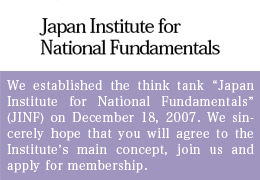Japan Must Publicize Full Information on the Worst Nuclear Power Plant Accident in History
On March 11, Chief Cabinet Secretary Yukio Edano announced the government will shortly implement a new evacuation program for residents within 20 kilometers of the crippled nuclear power plant in Fukushima Prefecture. Edano said the government will depart from the on-going program, which has uniformly designated for evacuation every village, town and city within a radius of 20 kilometers from the nuclear complex, and instead issue area-specific evacuation orders by taking into consideration such factors as the topography, wind direction, and radiological dosages.
Under the changed plans, two villages, two towns, and one city – all in Fukushima Prefecture – have been designated “planned evacuation areas.” They are: the villages of Iitate and Katsurao, the town of Namie and parts of the town of Kawamata, and the city of Minami-Sohma. Actually, all these municipalities are outside the original 20-kilometer radius, with the exception of the town of Kawamata, about 40 percent of which comes within the radius. Nevertheless, the residents will be urged to leave in about a month in anticipation of a situation in which they will likely be subject to at least 20 millisieverts of accumulated radiological dosages annually, should they choose to stay on.
I believe the government should be given some credit for having rightly adopted a new policy, making it possible to specify danger zones based on such factors as wind direction and topography. However, I doubt if this has sufficiently concluded the process of designating evacuation zones in connection with the troubles at the Fukushima nuclear complex.
I have with me vital materials showing the radiological dosages in a wide range of regions believed to have been affected by the explosions at Fukushima. These materials have been processed by Satoshi Sato, a nuclear expert who, for 18 years until 2002, was involved in nuclear-related businesses for General Electric in both Japan and the United States. Sato, who had been with the former Science and Technology Agency as a certified first class supervisor for radioactive protection before joining GE, is now a senior nuclear consultant with International Access Corporation – a consultancy with offices in Washington, D.C. and Tokyo specializing in nuclear technology and safety, among other fields. On the heels of the colossal catastrophe that hit northeast Japan on March 11, Sato hurriedly made his way back to Japan to start analyzing and investigating the situation centering around the Fukushima disaster from the standpoint of a top nuclear expert.
Departing Tokyo at 5 p.m. on April 4, Sato spent the next 14 hours in various spots across Saitama, Tochigi, and Fukushima prefectures, taking the Tohoku Expressway up and the Banetsu and Joban back. On his drive covering a total distance of 270 kilometers, Sato stopped every five kilometers to gauge the radiation level in the air and contamination of the earth’s surface.
I had a chance to interview Sato twice on April 5, just after he had returned from his overnight trip to the areas affected by the nuclear disaster. Explained Sato:
“We started our field trip at the Kawaguchi Junction, Saitama Prefecture. For some time after our departure, the radiation level indicated 0.01 milli-roentgen per hour, a normal count which equals the amount of radiation existing in nature.”
The roentgen refers to a radiological dosage coming from radioactive material. Meanwhile, the sievert refers to the effect of radiation on the human body. When the human body is exposed to radiation measured at 1 roentgen, it suffers a dose of almost 0.01 sievert. To put it simply, 1 sievert equals 100 roentgen.
Measured Values Reveal Harsh Reality
The standards set by the International Commission on Radiological Protection (ICRP) recommend that governments take immediate countermeasures in an emergency if residents are expected to be subject to 20 to 100 sieverts of accumulated radiation a year. Meanwhile, Prime Minister Naoto Kan and his DPJ (the Democratic Party of Japan) government had initially designated the area within a radius of 20 kilometers of the nuclear power station – where the residents ran the risk of being exposed to 50 millisieverts or more of radiation — as requiring evacuation. This decision was based on anti-disaster guidelines enacted by the Nuclear Safety Commission of Japan. As mentioned earlier, the latest designation by the government is designed to set a new standard, protecting residents from anything more than 20 millisieverts of accumulated radiation for the first year after the accident.
The results of radiation measurements by Sato earlier this month reveal the harsh reality of a widespread radioactive contamination, attributable to the disaster at the Fukushima nuclear complex. The radiation level in the villages and towns alongside the inland Tohoku Expressway was normal – to a point some 70 kilometers from the Kawaguchi Junction. However, a slightly higher level was detected in the 10-kilometer stretch beyond the 75-kilometer range. Conversely, the numerical value of radiation declined to normal again for the 25 kilometers past the 90-kilometer mark, steadily rising again after 120 kilometers, as Sato’s car moved closer towards the Fukushima No. 1 plant.
It must be pointed out, however, that the numerical values of radiation vary daily, making it impossible to come up with stable numbers over a period of, say, four to five days. Still, we cannot but pay particular attention to the data Sato’s spot-check produced this time, which obviously differs from the series of dubious government announcements which appear aimed at reducing the nation’s fear of radiation.
Pointing out that he wishes to emphasize certain crucial matters on the basis of his overnight spot-check of the affected areas in northeast Japan, Sato remarked:
“First and foremost, one should not ignore the possibility that areas with high radioactive density may be spreading far and wide beyond the 20 to 30 kilometer radius from the nuclear complex. In such a case, it is vital to come to grips with how the radioactive particles spread. As a matter of fact, radioactive particles emitted from the Fukushima No. 1 plant will never spread evenly in a concentric pattern. Consider it spreading more like clouds: that would make it easier to understand it.”
According to Sato, radioactive particles drift in the air like loosely clustered clouds, drifting with the wind into certain directions, or, should they hit an obstacle like a mountain, coming to a stop and dropping down to the ground. Sato pointed out that the areas affected by a high radioactive density following the explosion of the nuclear reactor at the Chernobyl atomic power station in Ukraine, were scattered around, instead of being confined to a strictly concentric area. Therefore, in the case of Fukushima, it would be hardly surprising to find some safe zones relatively near the damaged nuclear power plant, while some danger zones were spread across distant areas, according to Sato. He therefore believes it quite right that the government decided on April 11 to change the safety standard involving designation of areas requiring evacuation, adding:
“Those of us in the nuclear business refer to radioactivity in nature as ‘background radiation.’ If we are to most stringently abide by the standard set by the ICRP while taking into consideration background radiation, 20 millisieverts annually is by far the maximum tolerable amount of radiation the human body may be exposed to. The results of my spot check this time have shown radioactive doses easily exceeding this standard in a variety of locales across Fukushima Prefecture. Cities like Koriyama and Fukushima, designated as the evacuation centers for those affected, as they are more than 50 kilometers away from the nuclear power plant, are considered safe at present. However, if we take the international standard strictly, these two cities clearly fall in the category of areas unfit for habitation.”
Needed: Maximum Efforts for Information Collection, Analysis and Dissemination
Another stark reality that was confirmed by Sato’s data was contamination of the ground. It would be impossible to deny the possibility that areas with highly contaminated ground could be found here and there along the Tohoku and Joban expressways. Of course, there are radioactive particles having short half-lives, so it is unwise to become unnecessarily alarmed by a single sampling of data. However, it is also best to at least be as correctly informed as possible of the extent of contamination, as well as its nature, in the areas where radioactive contamination is suspected. Only by being well informed, can one cope with some degree of confidence with the current situation.
For that purpose, the government must urgently draw up maps showing precisely where the danger zones are. Sato, who this time took a U-shaped route via the Tohoku, Joban, and Banetsu expressways to conduct his monitoring, pointed out that maps can be drawn up with relative ease by conducting close spot checks on narrow lanes and streets accessible by car. Monitoring for radioactivity should also be conducted simultaneously in all other lanes and streets in other regions as well, contributing to maps that credibly show the hazardous areas. Based on such maps, areas fit for habitation, agriculture and livestock, and areas requiring evacuation should be determined. While one appreciates – up to a point, that is – that the DPJ administration has exercised caution, desperately trying to spare the nation undue anxiety and panic, more than a month has already passed since the disaster struck, with the government still unable to implement truly effective countermeasures. It is quite obvious that the government is gradually backing away from its hopeless fight to bring under control the crippled power plant – as well as from its fight against radiation without being able to mete out any effective countermeasures.
Early in the morning of April 12, the government raised the provisional severity level of the Fukushima crisis to the worst rating of seven in keeping with the standard set by the International Nuclear and Radiological Event Scale (INES). Ironically, the government had expressed the view on March 18 that the crisis would remain at level 5 – no worse than the Three Mile accident of March 1979. That the government has been compelled to adjust the level to 7 – worst on the sale of 1 to 7 – reflects the incredibly unsophisticated way the government has dealt with the aftermath of the disaster, proving beyond any shadow of a doubt that the Fukushima disaster has been caused by serious human error. The human error began when the government failed to obtain correct information pertaining to the trouble, thereby failing to analyze the situation correctly.
That having been the case, the government should now concentrate all its efforts to collect, analyze and disseminate correct information relating to the nuclear disaster, and take this as an opportunity to start putting the nation back on its feet again.
(Translated from “Renaissance Japan” column no. 457 in the April 21, 2011 issue of The Weekly Shincho.)








